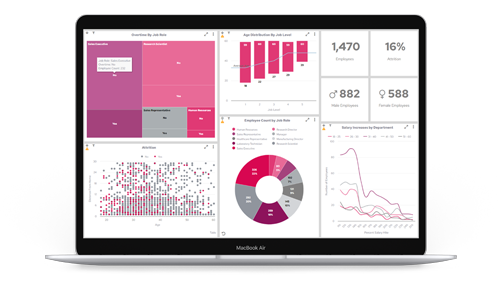Causal AI is predicted to bring about a whole new layer to the data analytics field and, through its unique approach to analysis, deliver more insightful information. This AI technique has been gaining a lot of recognition in the field, and recently featured in Gartner’s Hype Cycle under the theme of Emergent AI. But what exactly is Causal AI?
How Causal AI goes beyond Augmented Intelligence
To understand Causal AI, we need to take a step back to Augmented Intelligence. For those who are unfamiliar, Augmented Intelligence is a subset of Artificial Intelligence in which AI technologies use machine learning (ML) to analyze reams of data to support users with decision-making. The key differentiator between Artificial Intelligence (AI) and augmented intelligence is one of autonomy: AI is the automated aspect that is trained to run without human intervention, whereas Augmented Intelligence utilizes ML to analyze data, reporting the findings so human intelligence can take action. Due to the approach Augmented Intelligence takes, it could be considered a collaborative robot (co-bot) as it is designed to work alongside humans.
Augmented Intelligence gathers structured and unstructured data from multiple sources, which then goes on to analyze and interpret, applying deep learning that mimics a human brain’s ability to process data and see patterns. The output of this leads to a ‘big picture’ view of what the data shows, demonstrating the patterns and correlations that can be uncovered in the data. Whilst Augmented Intelligence has brought about a new stage in data-driven decision-making, it is limited in the fact that it can only present correlations and can’t provide any further reasoning behind why the correlation exists. This is where Causal AI comes in.
What is Causal AI?
Traditional ML models, including the likes of Augmented Intelligence, can identify the extent of which multiple events are related. Causal AI goes one step further to identify the root cause of events by understanding the effects of any variables that may have led to it, providing much deeper insight into the data. In essence, you could say that it ‘thinks like a human’. Causal AI is similar to human intelligence in the way it thinks and processes information. A human would use reasoning to understand the relationships between events to draw a conclusion, and similar to that effect Causal AI uses algorithms and models to identify causal relationships in data.
Traditional ML models use historic data, looking at variables whose values are correlated to a desired / undesired outcome. These models have no way of understanding which or how any of the variables caused the outcome.
Benefits of Causal AI vs. traditional ML
Traditional ML has definitely supported businesses in many ways, yet it does come with some limitations, inducing a limited view, narrow explainability, and high susceptibility to bias. The links and intermediaries between variables in these previous ML models are often ‘black boxed’ meaning users and even the programmers cannot easily see how the variables relate to the outcome.
However, Causal AI and the intrinsic nature of cause and effect means it can address many of these concerns.
- Explainability – Causal AI is at the cutting edge of explainable AI as it quite simply answers the question of ‘why’ rather than just presenting patterns. Beyond this, Causal AI takes effect in structural causal models that simulate the relationship between variables. Often this takes the form of a decision tree model, which for many users, can help with the explanation element. The explainability element also helps with the buy-in aspect from C-Suite Execs, which is especially important in the SaaS market.
- Bias – Causal AI can be the step forward to de-biasing algorithms. Causal AI can envision futures that are decoupled from historical data, enabling users to eliminate biases in input data.
- Forward-Thinking – Traditional ML shows correlations based on historical data but doesn’t necessarily apply it to your current circumstances or future scenarios. Due to the understanding of the cause and effect, Causal AI can be used to perform ‘what if’ analysis and reasoning for scenarios that have not yet occurred, helping those who use it to better prepare for the future. This would be placed in what’s referred to as a Potential Outcomes Framework.
- Auditable – Following on from the explainability point, Causal AI is so intrinsically auditable and therefore humans can review and understand the outcome before moving forward with any actions. This transparency means the outcome can also be scrutinized, making it easier to spot mistakes that may have crept into the data.
How we apply Causal AI in Pi Predict
Pi Predict is our predictive analytics module that delivers the power of foresight. Most BI or analytics platforms will just apply traditional ML algorithms that are trained to correlate datasets, whereas our module utilizes Causal AI to uncover the reasoning behind the outcome. Our module has the ability to find the causality of chosen variables based on historical data, all of which is demonstrated in our user-friendly decision tree model. Our solution then further empowers organizations to make highly-informed decisions by applying this reasoning to current data and employing ‘what if’ scenarios to discover how this causation could impact the business in the future. Pi Predict is a solution to bring the human and machine together.

Pi Predict in action
To explain this further, let’s take the scenario of a company looking to investigate employee attrition to uncover the core reason why people leave in the hope of preventing it from continuing in the future. Traditional ML could show you correlations of two datasets to show which groups had the highest rates of attrition; for example: in the age demographic category, the bracket aged 25-30 had the highest level of attrition in previous years. This view is very singular, whereas Causal AI would consider all variables at once to discover the cause amongst all possible factors that could cause people to leave the business. In the platform, users can simply select the area they would like to analyze, and the system will build a model that will pull in all employment data from past and current employees, alongside key variables that could impact the outcome from age, training courses taken, or even the number of days of overtime.
Through the analysis, Causal AI will uncover the variable that was the main cause for the employee attrition, which could have been employees that completed over 10 hours of overtime in a month. By discovering the true cause, a HR department could pinpoint where action needs to be taken.
The causal model understands how the characteristics interact. So, if we apply the same example, reducing overtime within the company may have a positive impact on some groups of employees yet a negative impact on others. Companies need to understand why characteristics are significant to understand the impact of change. This unique distinction is why Causal AI gives companies such valuable insight.
Pi Predict delivers foresight
This model can even be taken one step further and applied to current circumstances or ‘what if’ scenarios. For example, it’s great to understand the reason behind the employee attrition, but the purpose of the investigation is to prevent it from being a continued problem in the future. Therefore, the causality found can be overlayed with current employees to filter out those who have a high probability of following the pattern leading to them leaving the business (this is, of course, if the circumstance stays true to those of the past). This aids a HR department to focus attention on supporting employees with a high probability of attrition with the hope of keeping them happy in the workplace.

Causal AI round-up
Businesses are becoming increasingly dependent on data-driven decisions, but this needs to go beyond conventional predictive analytics. Casual AI will be the future of embedded analytics for SaaS applications as users demand more insightful information drawn from their data.























